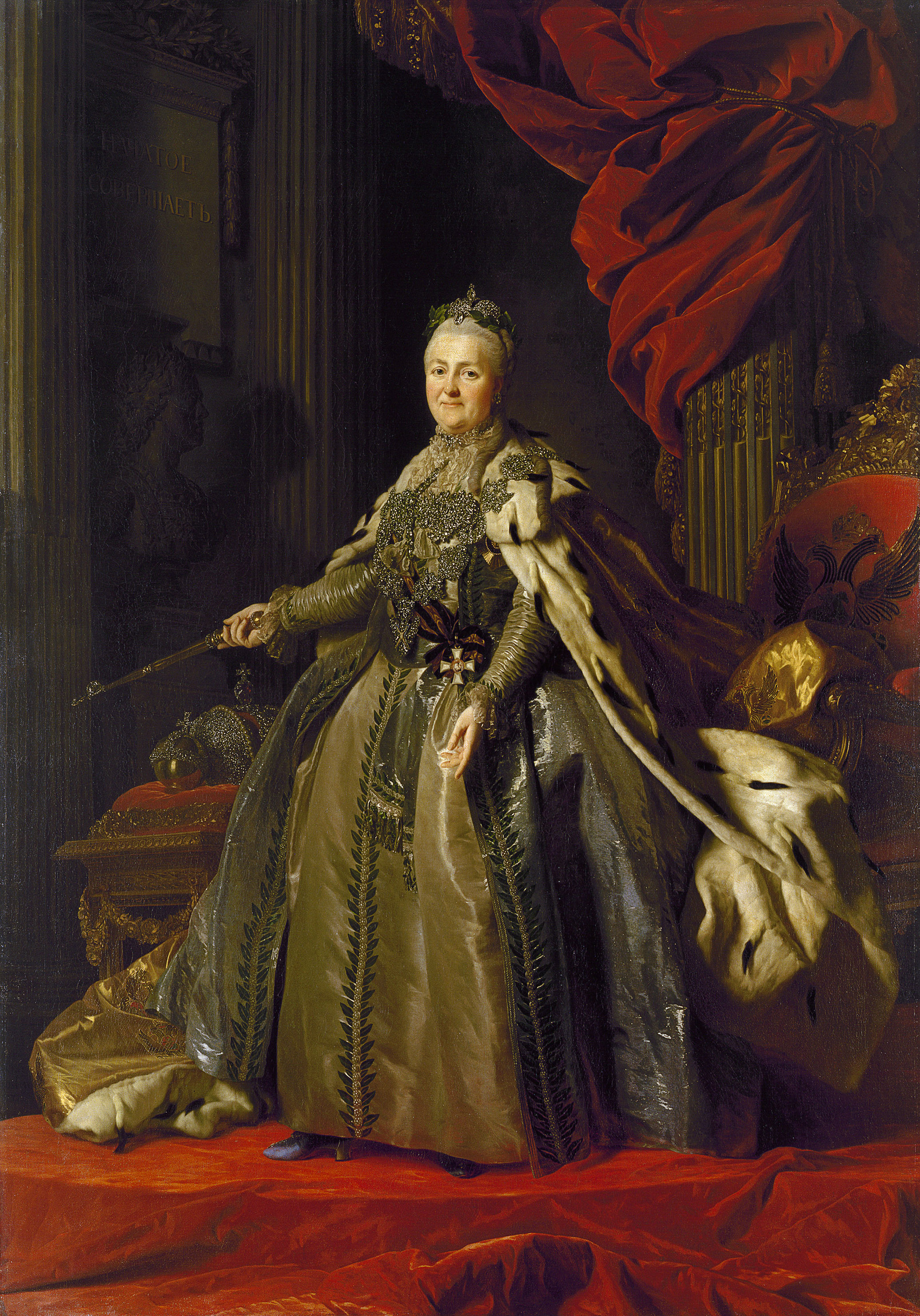
Alexander ROSLIN, (Swedish 1718–93), Portrait of Catherine II 1776–77. oil on canvas, 271.0 х 189.5 cm, The State Hermitage Museum, St Petersburg (Inv. no. ГЭ-1316), Acquired from the artist, 1777
Masterpieces from the Hermitage: The Legacy of Catherine the Great at the National Gallery of Victoria International until the 8th November 2015.
We enter the exhibition face-to-face with Catherine the Great in a portrait by Swedish artist Alexander Roslin. The Empress was not altogether impressed by the portrait, declaring that Roslin had made her look like ‘a Swedish cook, coarse and simple.’ Despite Catherine’s reservations, the portrait (which shows the Empress in ‘Slavonic’ dress, fastened with a diamond buckle and pointing toward a bust of Peter the Great) proved to be a successful representation and was copied numerous times. The painting is flanked by two busts of the philosophes Voltaire and Diderot by the little-known French sculptor Marie-Anne Collot. On some level, both men had an almost personal friendship with Catherine. In one letter, Voltaire complimented her as an ‘enlightened despot’ who stood in stark contrast to the excesses of the French monarchy. Diderot also maintained a correspondence, conversing with Catherine on ideas about philosophy, art and politics. Collot herself moved to Russia in the 1760s and became the official portrait sculptor to the Imperial court, where she remained until 1778. Catherine clearly appreciated the lively, informal poses that Collot employed and Collot’s bust of the empress herself (not in the exhibition but you can see it here) is very similar in its engaging sense of informality. In flanking Roslin’s portrait of Catherine with Collot’s busts of these two French intellectuals, the curators of the exhibition underline Catherine’s interest in the Enlightenment ideas emanating from France. This first room is the most tightly curated of the entire exhibition, deftly presenting Catherine the Great as ruler, ‘philosopher’, collector and patron of the arts. We are also reminded of the cosmopolitanism of Catherine’s court. She attracted to Russia artists from across Europe and also collected art from a diverse range of styles and periods: this room alone includes paintings, sculpture, architectural drawings and decorative arts from Russia, Germany, Italy, France, Sweden, England, Switzerland and France. These are not just works collected by Catherine herself, but also works produced by artists who received her patronage, and in some instances had a major hand in shaping the new ‘look’ of her cultural capital of St Petersburg. I would have liked some of these ideas about the cosmopolitanism of Catherine’s court and of Enlightenment Europe more broadly had been drawn out further in the exhibition. It is currently a focal point for research into eighteenth-century cultural life and this exhibition was surely a great opportunity to raise ideas about nationalism versus global citizenship, and about intercultural exchange in the arts.

Left | Marie-Anne Collot, Voltaire, France 1770s, State Hermitage Museum – Right | Marie-Anne Collot, Denis Diderot, France, 1772, Hermitage Museum.
The architectural drawings included in the exhibition show us the ‘look’ desired by a cultured Enlightenment-era monarch. The designs by Giacomo Quarenghi (Catherine’s court architect) for various buildings around St Petersburg are in a restrained neo-classical style. Other drawings attest to the great interest in architectural drawings of varying styles in the period when Catherine was collecting. A large wall of antique ruin images by Charles-Louis Clérisseau includes his designs for a trompe l’oeil ruin room for Father Leseur at the Trinita dei Monti church in Rome. Catherine apparently kept these drawings in her private rooms and it’s a shame that nothing much is made of her owning these images of a monk’s ‘hermitage’. The space at Trinita dei Monti was similarly used for social gatherings rather than silent retreat, and Catherine must have enjoyed the parallels with the spaces she herself was creating at the Hermitage in St Petersburg.
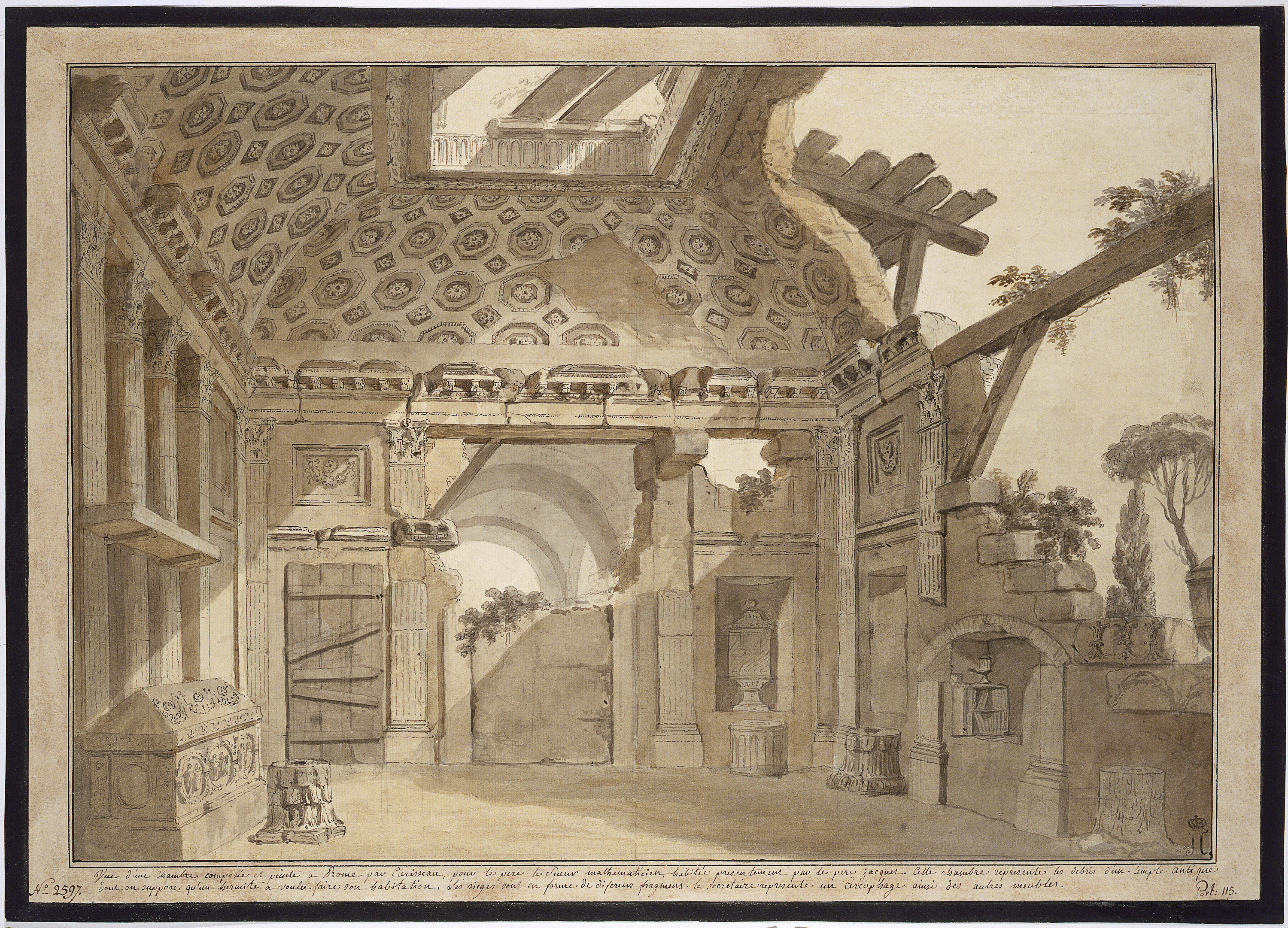
Charles-Louis CLÉRISSEAU (French 1721–1820), Design for the paintings in the cell of Father Lesueur in the Monastery of Santissima Trinità dei Monti in Rome 1766–68, pen and black and brown ink, brown and grey wash, 36.9 x 53.0 cm (sheet), State Hermitage Museum, St Petersburg (Inv. no. ОР-2597). Acquired from the artist by Catherine II on 5 May 1780, Provenance: before 1797
The next stage of the exhibition is mostly arranged along the lines of national schools moving from Italian to Flemish to Dutch to French. In each room the delineations are a bit fluid, Luca Giordano seems to have crept into the Flemish room and the four Van Dyck portraits are spread between the Flemish and Walpole rooms. Perhaps the finest work amongst those grouped with the Italian school is the large Bellotto painting of the Zwinger in Dresden, which shows a careful handling of light and shade that realistically captures the true effect of bright sunlight on architecture where sections are thrown in sharp relief, while others fall into shadow. Also notable in this room is the portrait by Domenico Capriolo. He isn’t an artist I know much about, but, I was struck by the rich colours of the portrait and the way the artist has captured the textures of fox fur, dark brown curls of hair and heavy brightly-coloured fabrics of his sleeve.
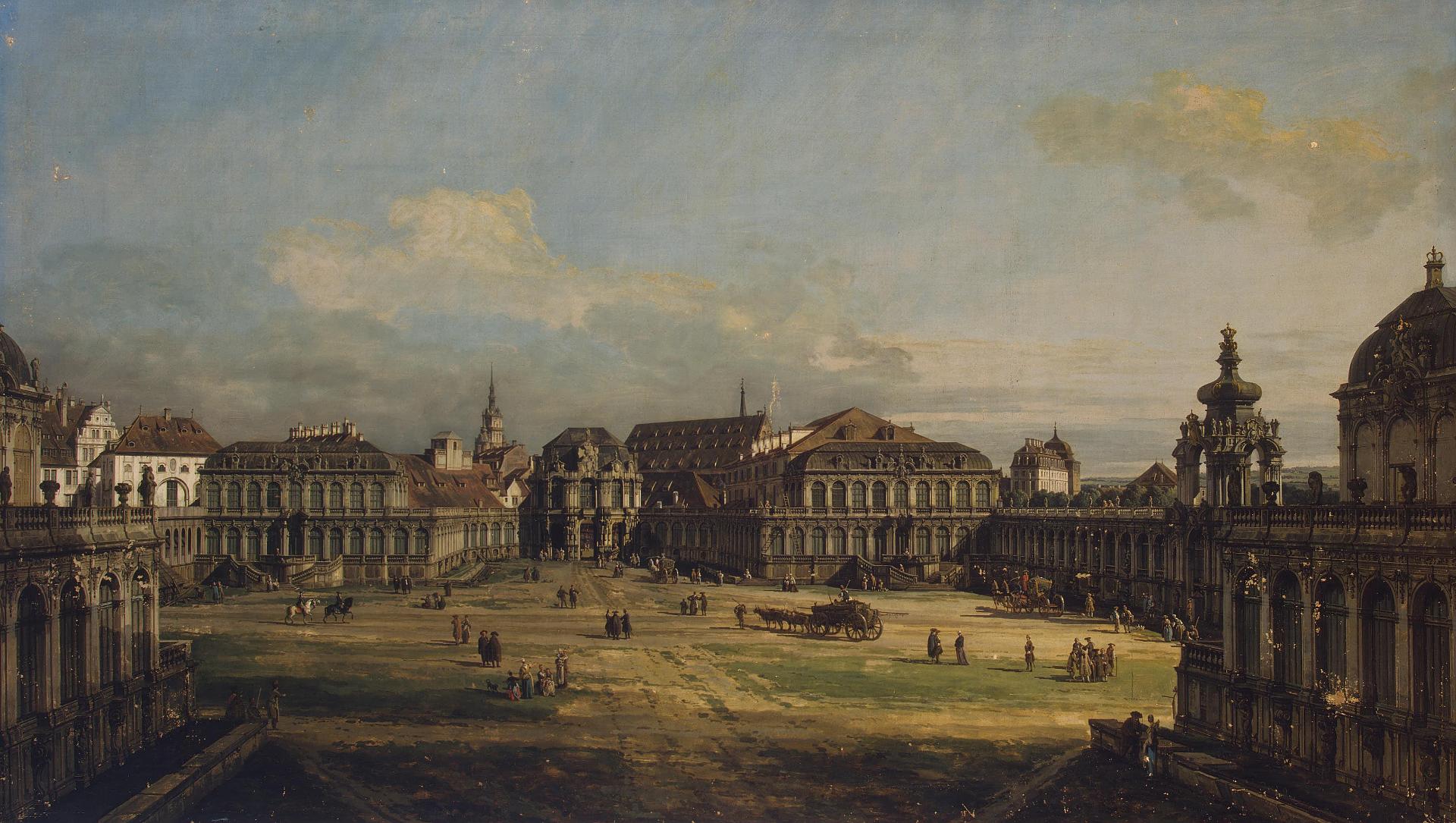
Bernardo Bellotto, Zwinger in Dresden, Italy, 1752, oil on canvas, 131×233 cm, State Hermitage Museum, (Inventory Number: ГЭ-205).
Indeed, the portraits were for me some of the most interesting works in the exhibition. There are several works by two of the finest portraitists of the seventeenth-century: Rembrandt and Van Dyck. In the room dedicated to the Flemish school I enjoyed the self-portrait of the artist Cornelis de Vos with his family (an artist known to NGV visitors via his intimate mother and daughter portrait acquired in 2009). It struck me after looking at it for several minutes that although on first glance this richly attired family seems carefully posed in a static group, they are in fact presented as though in the middle of a walk. The young boy of the family is heading off the right-hand side of the canvas, barely giving the viewer a second glance. The central group of women seem to have paused momentarily and small gestures and details give us a sense that this portrait is intended to capture the family in an informal setting. The youngest child is learning to walk and her older sister holds a small rope, probably intended to help her stay upright, while the toddler’s hand firmly grips that of her mother beside her.
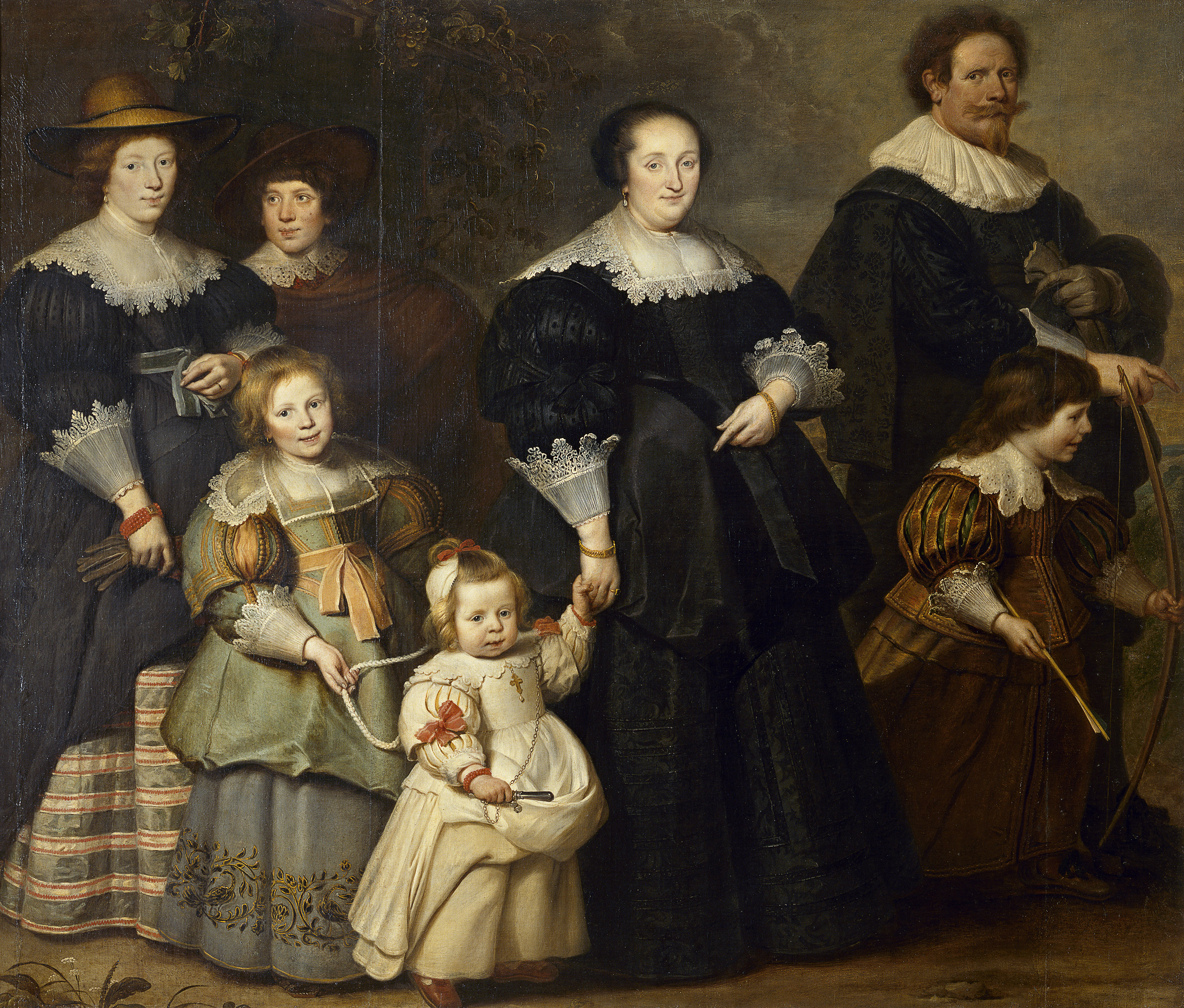
Cornelis de VOS, (Dutch/Flemish(c. 1584–1651), Self-portrait of the artist with his wife Suzanne Cock and their children (c. 1634), oil on canvas, 185.5 х 221.0 cm,
The State Hermitage Museum, St Petersburg, (Inv. no. ГЭ-623), Donated by Prince G. A. Potemkin, 1780s
The exhibition also includes a range of smaller-scale works: landscapes, genre scenes, decorative arts in a small space made over as a ‘Chinoiserie cabinet’, and, two long walls dedicated to drawings. These are works that one is perhaps less likely to see on a visit to the Hermitage. Drawings and decorative arts, for instance, are not on regular display, and in my experience smaller works are easy to pass by in the huge European art museums. Loan exhibitions often give us the chance to stop and spend time looking at art we might not otherwise have paid as much attention to. Amongst those I most enjoyed is a small painting by Metsu, an underrated painter in my opinion, well worth a closer look. The painting’s subject is ‘The doctor’s visit’, and we can see a rather poorly looking woman leaning back in a chair while a doctor examines something in a glass vessel. But the real subject of this small painting is Metsu’s virtuosic ability to convincingly render different fabrics and surfaces, from the tightly woven carpet to thick linen and thick heavy fur trim. His attention to capturing the effects of light falling on glass, metal and fabric make this painting a tiny jewel of technical mastery.
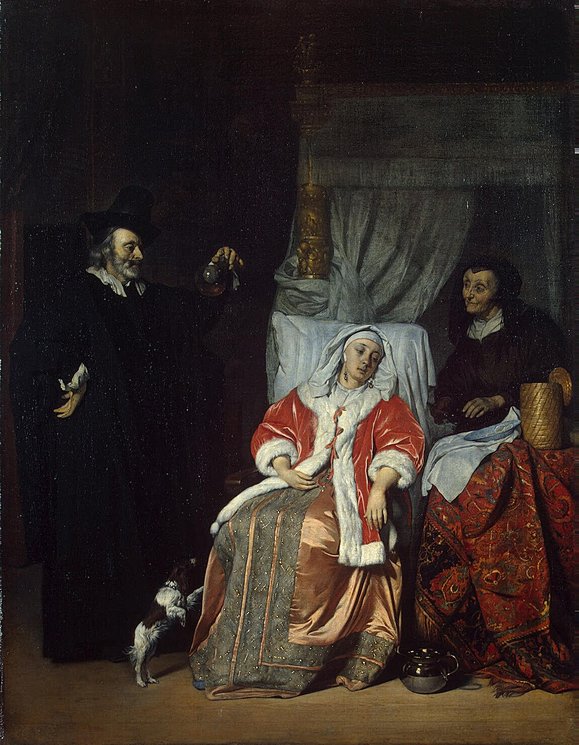
Gabriel Metsu, Doctor’s Visit, 1660s, oil on canvas, 61.5 x 47.5cm, State Hermitage Exhibition,
The display of Jean-Baptiste Greuze’s The Paralytic (or Filial Piety) alongside its preparatory drawings (which Catherine purchased along with the painting) is a strong point of the exhibition. Diderot recommended the purchase of this painting to Catherine as much to support Greuze as to help Catherine with her collection. Diderot regarded Greuze as the most important French artist of his day for the way that he could create an emotionally charged and dramatically unified scene in which the onlooker would themselves become and be moved by the same emotions as the people depicted in the painting. When it was exhibited in Paris at the Salon in 1763 it literally moved people to tears and Diderot wrote that this painting ‘captured an unusual moment’: the gentle kindness of the son-in-law carefully feeding his father-in-law, has moved the paralyzed older man, who expresses his thanks; this moment has captured the attention of the entire family, who look on, emotionally moved by the moment before them.
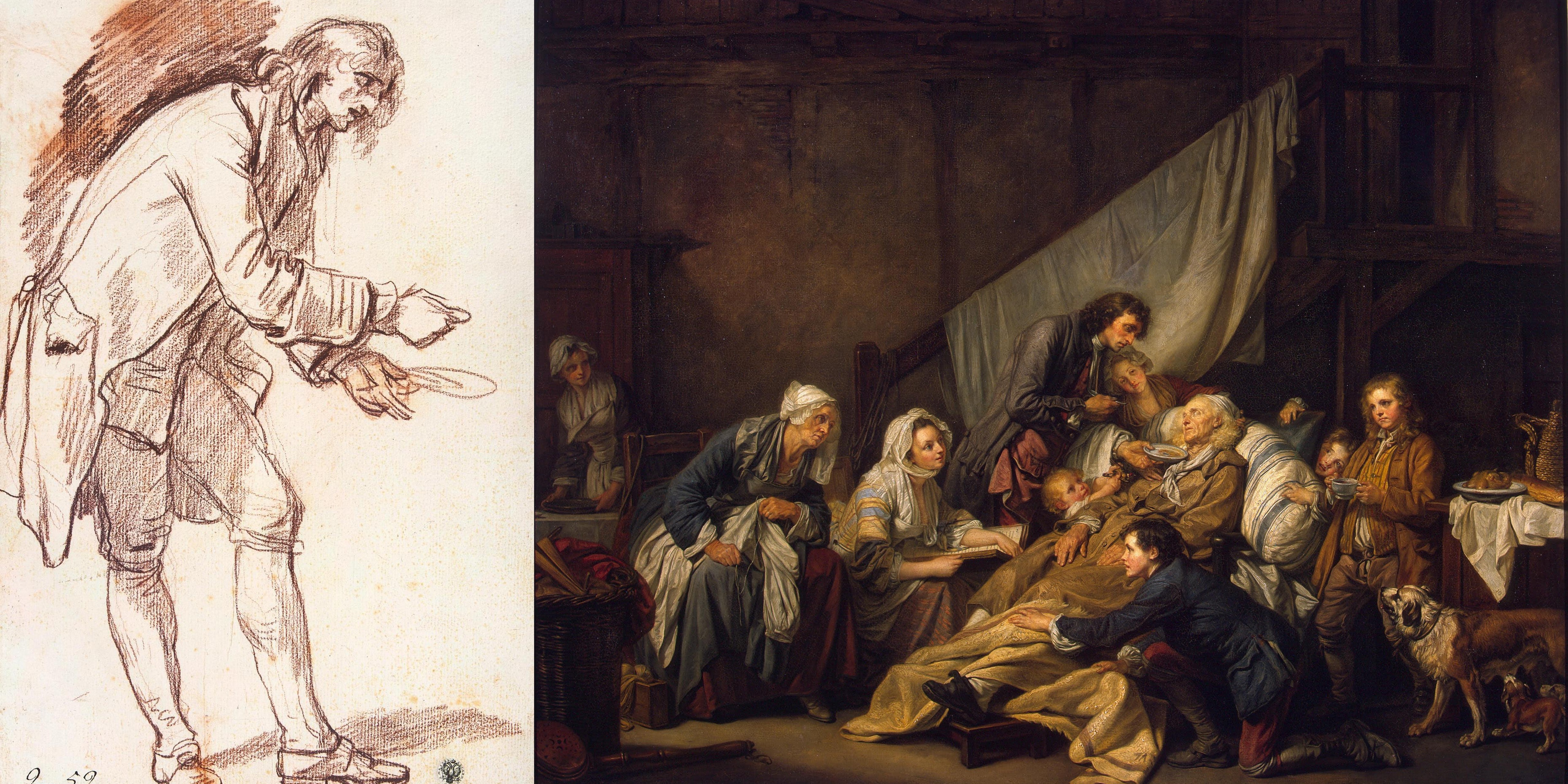
Jean-Baptiste GREUZE, French 1725–1805, Study for The paralytic (1760s), red and black chalk, 49.3 x 40.0 cm (sheet), The State Hermitage Museum, St Petersburg (Inv. no. ОР-14727). Acquired from the artist in 1769 for the Museum of the Academy of Arts. Transferred to the Hermitage in 1924 | Right – Jean-Baptiste GREUZE, The Paralytic, 1763, oil on canvas, 115 x 146cm, State Hermitage Museum
The Walpole room is a great idea as it represents Catherine’s ability to buy up entire collections of art. The collection was put together by Robert Walpole, first Prime Minister of Britain, but sold off by his heirs after his death. The loss of the collection was regarded by many as a national tragedy. This famous collection was the subject of a very successful exhibition held at Houghton Hall a few years ago, when many of the Hermitage pictures returned to their former home for a brief stay. Unfortunately the works chosen for the NGV exhibition don’t really capture the substance of Walpole’s collection and perhaps this is impossible to do with only a handful of paintings. Walpole himself is there in the great portrait by Jean-Baptiste Vanloo and the Van Dyck Portrait of Philadelphia and Elizabeth Wharton is a fine example of why this artist was considered the leading portrait painter in seventeenth-century England.
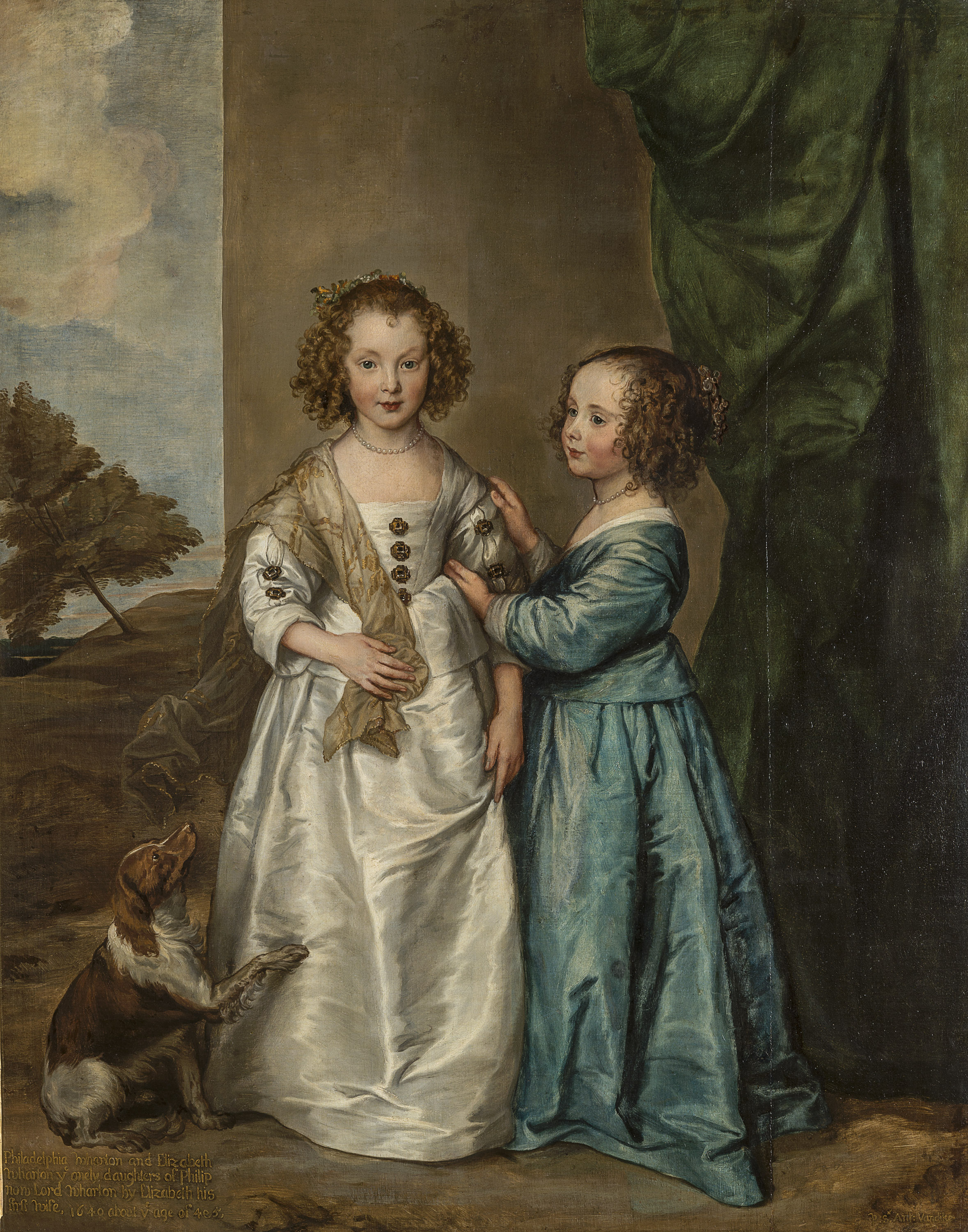
Anthony van DYCK (Flemish 1599–1641), Portrait of Philadelphia and Elizabeth Wharton, 1640, oil on canvas, 162.0 х 130.0 cm, The State Hermitage Museum, St Petersburg (Inv. no. ГЭ-533), Acquired from the collection of Sir Robert Walpole, Houghton Hall, 1779
The odd collection of paintings chosen for the Walpole room does rather draw attention to the slightly unfocused selection of works for the exhibition as a whole. Strong ideas like the Walpole Collection are often let down by rather weak choices of paintings. In the ‘French Taste’ room, for instance, two of the best eighteenth-century artists Watteau and Boucher are represented by rather uninspiring paintings. Perhaps a smaller, more tightly presented exhibition would have been more satisfying with works that provided a focus on one or two aspects of the Hermitage collection – such as Dutch and Flemish paintings. The main theme explored in the exhibition is Catherine as a collector of art, which is strongly presented in the first room of the exhibition, but, overall I felt that the social and cultural world of Catherine the Great’s Russia wasn’t drawn out strongly enough. I’m not sure I came away from the exhibition with an especially strong sense of the richness of the Hermitage collections or of the transformation of Russian culture during the rule of Catherine the Great. Though to the NGV’s credit the fine program of lectures they have put on does go some way to addressing this. Despite these misgivings there was certainly enough in this exhibition to keep me occupied for several hours over several visits.
© Katrina Grant 2015
